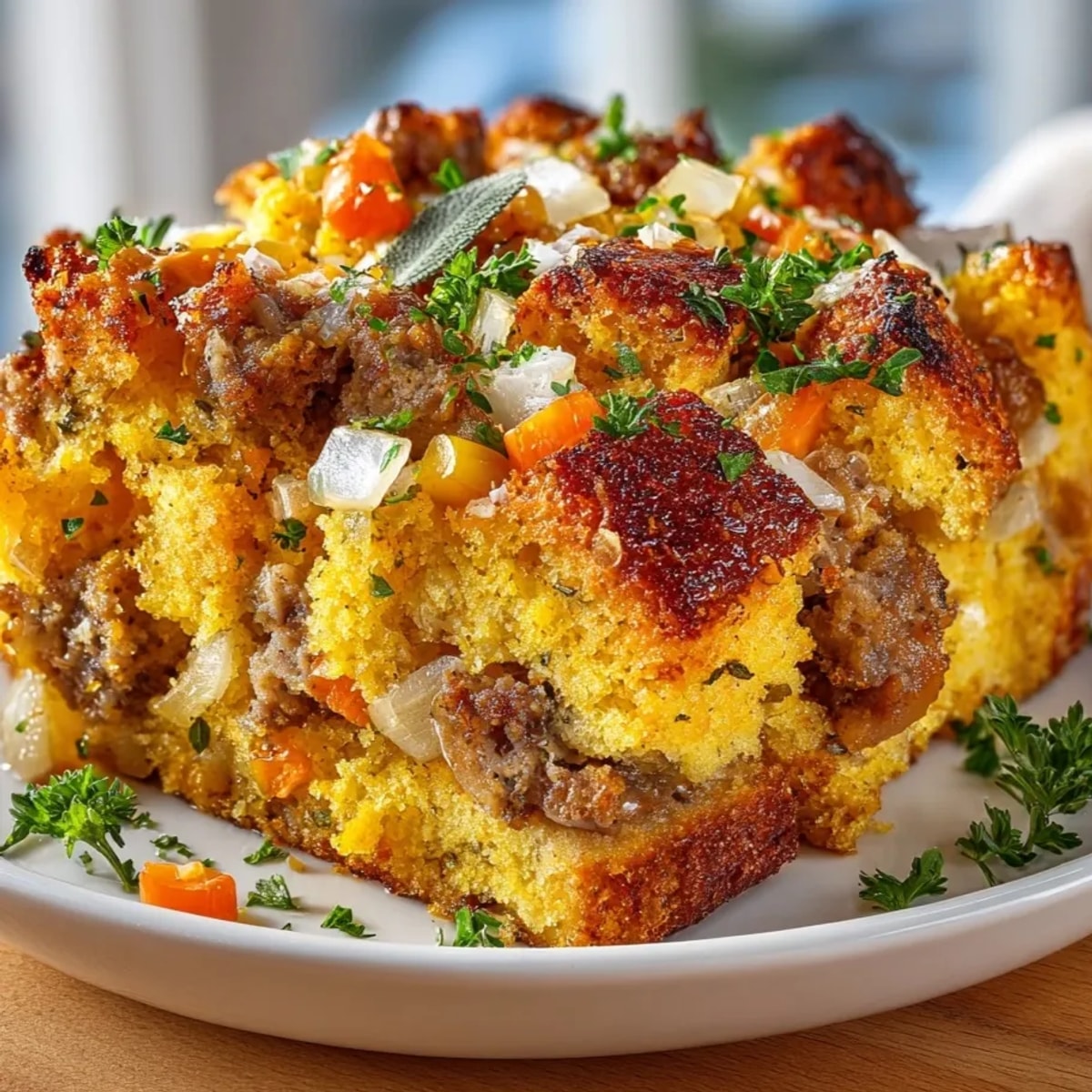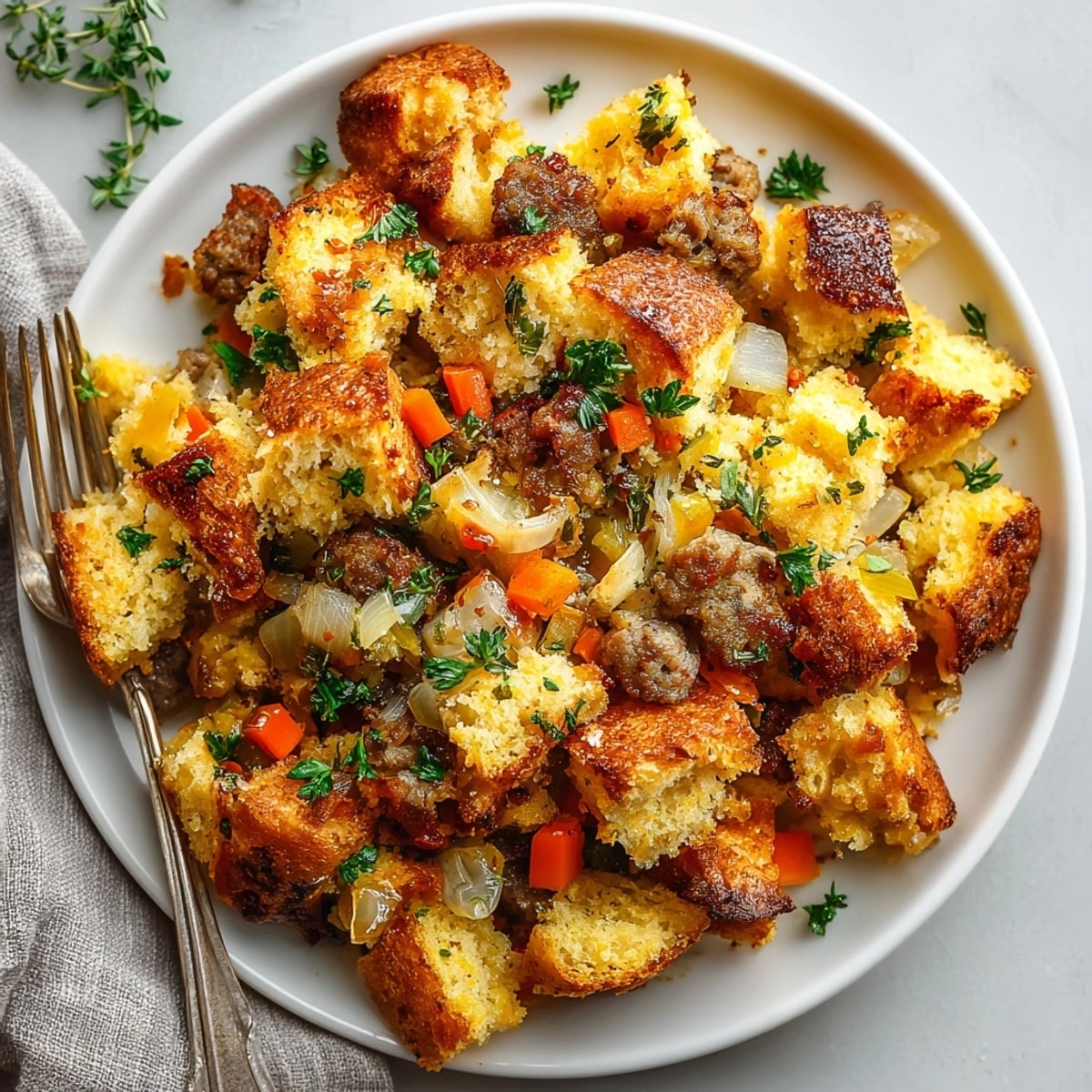 Save
Save This savory sage sausage cornbread stuffing brings together the perfect balance of textures and flavors for your holiday table. The golden cornbread provides a sweet base that soaks up all the savory goodness from the herbs and sausage, creating a side dish that often steals the spotlight from the main course.
I first made this stuffing when I was hosting Thanksgiving for the first time and panicked about making something everyone would enjoy. Now it's the dish my family requests most often during the holiday season, and I've even caught my brother sneaking cold leftovers straight from the refrigerator at midnight.
Ingredients
- Cornbread cubes preferably day old for the perfect texture that absorbs flavors without becoming mushy
- Sage pork sausage adds richness and depth look for high quality sausage with visible herbs and minimal additives
- Onion celery and carrot create the essential aromatic base that defines traditional stuffing
- Fresh herbs especially sage and thyme provide brightness that dried herbs simply cannot match
- Chicken broth use homemade if possible for cleaner flavor but a good quality low sodium store bought works well too
- Eggs act as a binding agent creating structure without making the stuffing heavy
Instructions
- Toasting the Cornbread:
- Spread your cornbread cubes evenly on a baking sheet making sure they have space between them for proper air circulation. Toast them at 350°F for exactly 10 minutes until they develop a light golden exterior but still maintain some softness in the center. This critical step ensures your stuffing has structure and doesn't turn to mush when the liquid is added.
- Preparing the Sausage:
- Break the sausage into small pieces as it cooks in the skillet. You want varied sizes from small crumbles to slightly larger pieces for textural interest throughout the stuffing. Cook until you see good caramelization on the edges which typically takes about 7 minutes on medium heat. The fond that develops on the pan will add tremendous flavor to your vegetables in the next step.
- Creating the Aromatic Base:
- Use the same skillet with the sausage drippings to cook your vegetables. The mirepoix of onion celery and carrot should be cut to similar sizes for even cooking. Sauté them until they become translucent and just begin to caramelize at the edges about 6 minutes. Add the garlic and herbs only in the final minute as they can burn easily and become bitter.
- Combining Components:
- When mixing the cornbread with the sausage and vegetable mixture use a folding motion rather than stirring. This preserves the integrity of the cornbread pieces allowing some to remain intact while others break down slightly to create the perfect stuffing texture. Season generously as the cornbread will dilute the overall flavor.
- Adding the Liquid:
- Pour the egg and broth mixture around the edges of the bowl first then gently fold it through. The mixture should be moist but not soggy. If your cornbread was particularly dry you might need an extra splash of broth. Let it sit for 2 minutes before transferring to the baking dish so the cornbread can begin absorbing the liquid.
- Baking Strategy:
- Baking covered first keeps the stuffing moist throughout while the final uncovered baking creates the desirable contrast between the crispy top and tender interior. Look for a golden brown surface with some pieces poking up getting extra crispy. These textural differences are what make great stuffing memorable.
 Save
Save Sage is truly the star of this recipe. I grow several varieties in my garden and have found that fresh garden sage has an aromatic quality that transforms this stuffing into something extraordinary. My grandmother taught me that rubbing the sage leaves between my palms before chopping releases the oils and intensifies the flavor throughout the dish.
Make-Ahead Magic
This stuffing actually benefits from being made ahead of time. Prepare everything up to the point of baking, cover tightly, and refrigerate overnight. The resting time allows the flavors to meld beautifully and the cornbread to fully absorb the savory broth. When ready to bake, remove from the refrigerator 30 minutes before putting in the oven and add an extra 10 minutes to the covered baking time to account for the chilled temperature.
Cornbread Considerations
While store bought cornbread works perfectly fine, homemade cornbread takes this stuffing to another level. For the best texture in your stuffing, make your cornbread 1-2 days ahead and let it dry out slightly. If you prefer a sweeter stuffing, use a cornbread with a touch of honey or sugar. For a more savory profile, choose a cornbread made with minimal sugar and perhaps some corn kernels for added texture and flavor.
Regional Variations
This stuffing has roots in Southern cooking traditions, where cornbread stuffing is often preferred over white bread varieties. In the Deep South, you might find additions like pecans or dried cranberries for sweetness and texture. Gulf Coast variations sometimes include oysters for a briny contrast to the sweet cornbread. In the Southwest, green chilies and pepper jack cheese create a spicier version that pairs beautifully with smoked turkey.
Serving Suggestions
Serve this stuffing alongside roast turkey or chicken for traditional holiday meals. Use it as a bed for roasted vegetables to create a complete vegetarian main course by omitting the sausage. Repurpose leftovers into savory breakfast muffins by mixing with extra eggs and baking in a muffin tin.
Dietary Adaptations
For those with dietary restrictions, this stuffing can be easily modified. Vegetarians can skip the sausage and use vegetable broth, adding mushrooms sautéed in butter for umami depth. For a dairy-free version, substitute olive oil for the butter. Gluten-sensitive guests will appreciate using certified gluten-free cornbread and checking sausage labels carefully, as some contain fillers with gluten.
 Save
Save This stuffing is a flavorful and comforting addition to any holiday meal. It pairs wonderfully with traditional roasted meats or can stand alone as a delicious side.
Recipe FAQ Section
- → What kind of cornbread works best?
Day-old homemade or store-bought cornbread with a sturdy texture holds up well and absorbs flavors without becoming mushy.
- → Can I make it gluten-free?
Yes. Use gluten-free cornbread and check sausage ingredients for gluten to offer an allergen-friendly option.
- → How can I make it spicier?
Try hot Italian sausage or add a pinch of red pepper flakes during the sauté for extra heat and depth.
- → What proteins pair well with this dish?
It’s especially delicious alongside roast turkey, chicken, or pork, making it versatile for many occasions.
- → How do I prevent it from drying out?
Cover with foil for most of the baking time and only uncover toward the end to crisp the top without losing moisture.
- → Can I prep it ahead?
Yes. Assemble ahead, refrigerate, then bake just before serving for convenience without sacrificing flavor or texture.